Fossil Feathers, Winging & Singing: The Breakthrough Bird Research of Julia Clarke
November 20, 2017
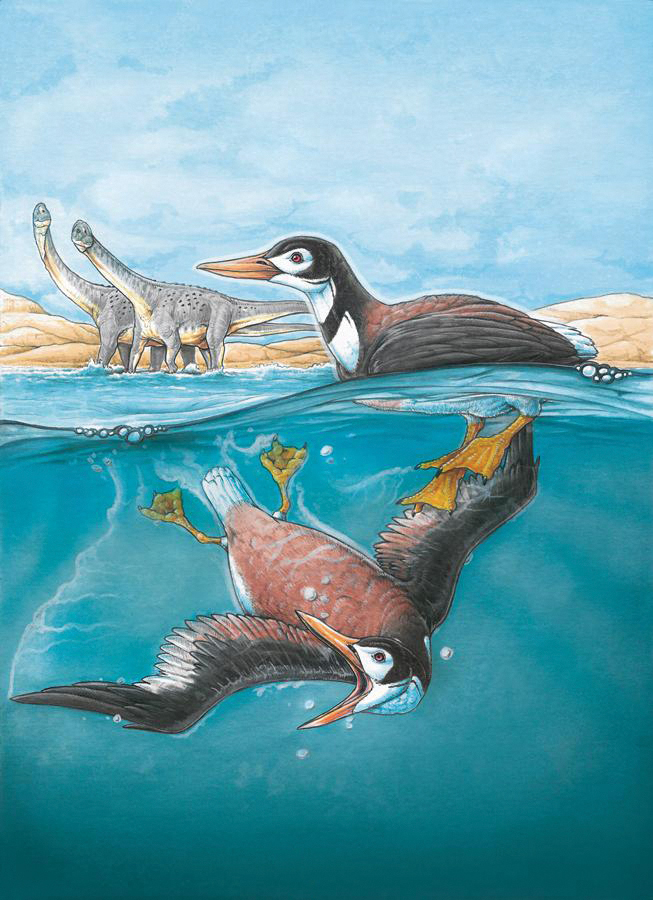
Antarctica wasn’t always a frozen, desolate continent. About 70 million years ago during the Cretaceous Period, it was green, lush and teeming with dinosaurs. Thanks to discoveries made by Jackson School of Geosciences Professor Julia Clarke and her collaborators, we know that during the Age of Dinosaurs the continent was also home to a much more familiar looking inhabitant: Vegavis iaai, an extinct member of the modern bird group that resembled a duck or goose and may have honked like one, too.
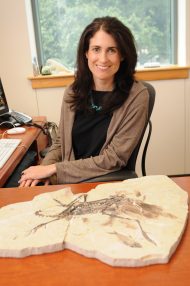
Argentine researchers found the first Vegavis fossil on Antarctica’s Vega Island in 1992. In 2005, Clarke, then a research curator at the North Carolina Museum of Natural Sciences, led a detailed examination of the fossil and found that it belonged to the same evolutionary order as modern-day ducks and geese. The finding was the first hard proof of modern birds living during the Cretaceous, a theory that evolutionary research suggested but needed bones to confirm.
“The really exciting thing about Vegavis was that, in most people’s minds, it was the first really, really good fossil evidence for a modern bird — in this case the duck group — living in the Age of Dinosaurs,” said Matt Lamanna, a curator at the Carnegie Museum of Natural History and a co-leader with Clarke of a 2016 fossil-hunting expedition to Antarctica supported by the National Science Foundation.
In the fall of 2016, Clarke and another team of collaborators announced that a second, even better preserved Vegavis fossil included the syrinx, the bird vocal organ. Its presence in the ancient bird, but not in other dinosaurs, indicates that the organ was not something birds likely inherited from their theropod dinosaur forefathers and mothers. (In case you missed it: scientists classify birds as living dinosaurs, the sole dinosaur lineage that survived the asteroid impact at the end of the Cretaceous that snuffed out all the others.) According to Clarke, the syrinx discovery could open the door to a new type of research into sound generation in extinct animals, and how it relates to sounds made by animals living today.

“I think that our work on the syrinx sets a starting point for studying other fossil records of vocal behavior or vocalization,” Clarke said. “We’re doing this in birds, but it can become a model for looking at similar questions in other animals.”
Clarke’s Vegavis discoveries are all smaller parts to a bigger question she’s chasing: how and why do unique bird characteristics — from feathers to birdsong — arise? Her Vegavis research exemplifies that these big questions can help strengthen current fields of study, while forging brand new research directions. As a part of the Jackson School faculty since 2009, Clarke has been mentoring the next generation of geosciences researchers as they take on their own big questions, showing that the so-called “impossible questions” can have big returns.
“I really like the hard questions,” Clarke said. “The ones we think we
can’t answer.”
Clarke’s Vegavis research is just part of the story. She has been part of
ground-breaking discoveries on feather evolution and coloration, and lately, bird vocalization. It’s work that benefits from Clarke’s curious worldview that has resulted in numerous international collaborations and fossil-hunting excursions across the globe.
“If we want to understand the world, it’s a global enterprise,” Clarke said. “A big component of my research is international research, and I think it’s key to get data points from some of the most remote and inaccessible places.”
Feather Finds
When Clarke started graduate school at Yale in the 1990s, the first feathered dinosaurs had just been discovered. That new finding, combined with field experience in Argentina with a paleontologist who was working on the evolution of birds, made a compelling case for studying birds in the fossil record, Clarke said.
“It was a lot of new data and a lot of possibilities the year I started grad school,” Clarke said. “I could have asked similar questions about a lot of different groups and been really happy, but it was just timely to work on bird origins.”
Early in her career, Clarke dedicated a large amount of time to describing fossils, honing her observational skills, and building a strong foundational knowledge of animal anatomy. Clarke said that this strong technical knowledge is at the core of the questions she asks.
“I don’t think we can even imagine the questions you want to ask until you have that basis in anatomy and how we study anatomy and what are cutting edge tool kits for studying anatomy generally,” Clarke said. “And once you get into that you can go, ‘How does this structure work, why is that that shape, that’s weird,’ and let basic curiosity take you to some new area.”
Her sharp eye led to an important discovery in 2008. On a fossil hunting expedition in Peru, her research team discovered a gigantic species of extinct penguin, dubbed Inkayacu, which lived about 36 million years ago during the Eocene and stood about five feet tall. But the most exciting part of the discovery was that the penguin’s feathers were preserved.
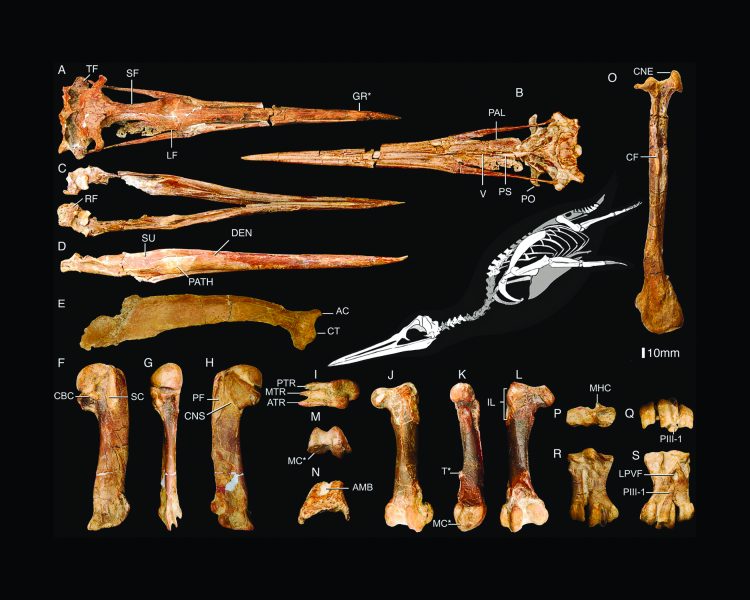
The feathers contained impressions of melanosomes, color containing organelles, which allowed the team to learn that the penguin was gray and reddish brown rather than the tuxedo that’s in vogue for most of its relatives living today. The pigment in the melanosome had long degraded; to determine the color of the feathers, the research team studied the shape of the preserved melanosomes — a feature determined in part by the pigment they once contained. The penguin discovery was important for its own sake, making the cover of the journal Science when it was published in 2010. But it’s also significant because it helped pave the way for research into feather coloration in general.
Shortly after the publication of the penguin research, Clarke and a team of collaborators deciphered the plumage colors of chicken-sized dinosaurs with more than a passing resemblance to modern birds. In 2010 they found that Anchiornis huxleyi — a four-winged dinosaur that lived 150 million years ago during the Jurassic in China’s Liaoning Province — had distinctive black, white and red markings similar to a modern red-bellied woodpecker.
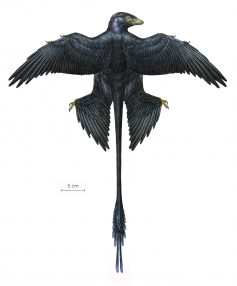
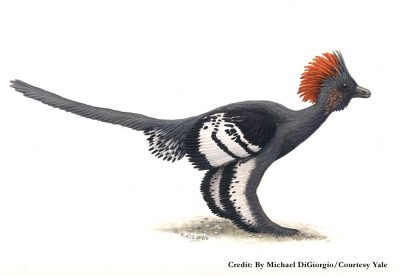
Two years later, Clarke and collaborators found that Microraptor, a Cretaceous dinosaur from the same province as Anchiornis, was a shiny, iridescent black, like the feathers of starlings and grackles today.
Clarke’s research on feather coloration is helping us envision the feathered dinosaurs of the Mesozoic Era more than 100 million years later, from the Holocene. However, she notes that studying the plumage color of individual birds and feathered dinosaurs is a means to understanding the bigger evolutionary picture. Her latest paper on feather coloration, published in Nature in 2014, integrated the dinosaur findings and compared them to nearly 200 melanosome samples taken from across vertebrates, including specimens of animals living today and fossils. The research found that an increase in melanosome diversity — and hence color — appeared with the first feathers.
“What I like to think I’m good at asking is, ‘Well, OK, we can say something about a dinosaur’s coloration, but what does that tell us about a major system that governs animal coloration,’” Clarke said. “The last major paper we had on coloration was about the melanin based color system and how that evolved.”
She adds that the work the team did on plumage coloration was important to the field of paleontology because it helped prove that fossils record evidence of ancient colors.
“Only a few years ago, we never thought we could use the fossil record to study coloration,” Clarke said.
Bird Calls to Dinosaur Booms
These days, Clarke has set aside most of her feather-coloration research to focus on the evolution of bird vocalizations. The discovery of the Vegavis syrinx last year opened doors to comparing the sound structures of living birds with ancestors from the Age of Dinosaurs, Clarke said, a field of study that has hardly been touched on by other scientists.
“The starting point here is the discovery of the fossil avian vocal organ, but we are also doing really core work on trying to figure out what’s changed,” Clarke said. “I don’t just describe fossils. I do a lot of work on living organisms so I can ask new questions about fossils.”
In some cases, the research on modern birds can not only give insight into a particular fossil, but a behavior of a range of extinct animals. Last year, Clarke and her collaborators turned their attention to closed-mouth vocalizations in birds and related reptiles, such as the coos of doves and the booming rumbles of crocodiles that are generated through throat inflation rather than by passing air through the syrinx, an organ that’s unique to birds. Not all birds and
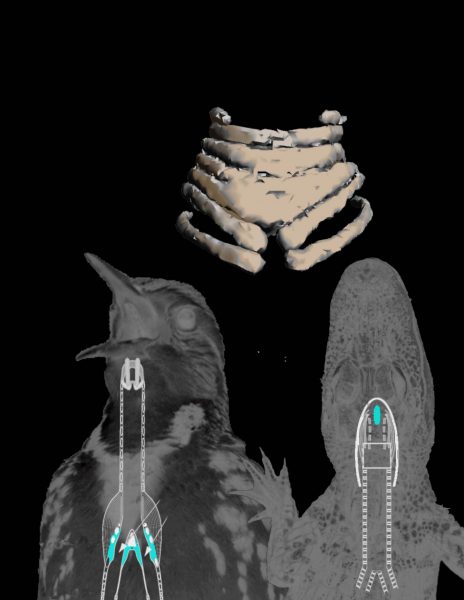
reptiles can make these closed-mouth sounds.
By statistically analyzing the characteristics associated with the ability or lack of it across 208 bird species, Clarke and her team determined that closed-mouth vocalization evolved at least 16 times in living archosaurs, the group that includes birds, crocodiles and alligators, and is associated with having a relatively large body size.
Since dinosaurs are also part of the archosaur group, Clarke and her collaborators suggest that it’s not a stretch to think that some of the larger-sized ones — and there were plenty — could also make closed mouth sounds.
“This makes for a very different Jurassic world. Not only were dinosaurs feathered, but they may have had bulging necks and made booming, closed-mouth sounds,” Clarke said in the news release announcing the research finding.
Impossible Questions, Innovative Research
From feathers to vocalization and a variety of other research streams along the way, Clarke has always kept the big picture in mind as she conducts her work. Lamanna said that Clarke’s clear focus on larger research objectives is an asset for any research team, especially in Antarctica, where the environment can cause its own set of distractions.
“Julia is super driven and focused, more so than almost anyone I’ve ever worked with,” Lamanna said. “Given the conditions in Antarctica, it can be easy even for seasoned field workers to lose track of goals, or to focus on things that don’t matter so much; but Julia just never loses sight of why we’re there.”
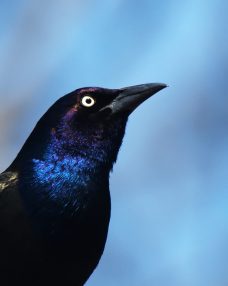
But Clarke doesn’t view her research approach as something unique to her. This spring, she spent a semester teaching a joint undergraduate and graduate course called Curiosity to Question about how to approach and conduct research. The new class encouraged students to embrace questions that they couldn’t answer and then develop research around related questions that they could, with students getting hands-on experience conducting research under Clarke’s guidance.
“People were surprised with how much they could get done,” said Sarah Davis, a first-year Ph.D. student advised by Clarke and a student in the course. “Julia was helpful in that narrowing down process.”
As her own research findings show, Clarke’s advice to pick a supposedly unanswerable question and then chip away at it with available data has made real scientific progress into what were once thought of as impossible research areas. From melanosomes came a colorful Jurassic world. And from a fossilized syrinx and modern analytical techniques came the calls of extinct birds and dinosaurs.
Clarke’s own crop of Ph.D. students is asking “impossible” questions of their own. For example, Davis is researching feather coloration. But unlike Clarke’s research, which focused on feathers colored by melanin, Davis is branching off into a new direction with potentially even more avenues to explore. She’s studying feather pigments made from carotenoids, a class of organic molecules that come strictly from an animal’s diet. They’re responsible for vibrant bird feathers, such as the pink of flamingos and the red of cardinals, as well as vital functions like immune system response and vision.
“It’s an interesting mechanism that’s unique and has the potential to have been around for a very long time because it’s seen in a lot of modern-day birds,” Davis said. “So I’m interested when this basic, fundamental nutritional thing got co-opted to make the really bright and pretty colors.”
In true Clarke fashion, Davis knows she’s on the right track because of the constant questions her work keeps uncovering.
“The more I continue on my current project, the more questions I find,” Davis said.
Back to the Newsletter